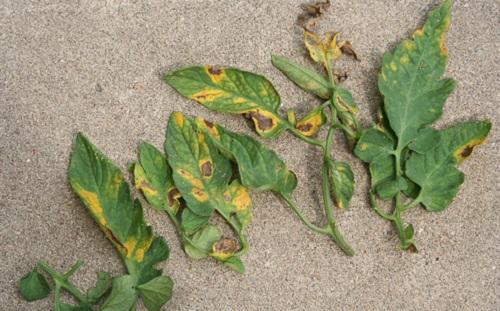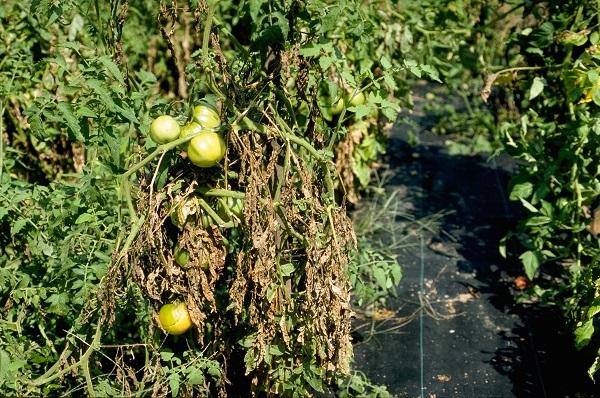Brown spots on leaves at the bottom of tomato plants
Early blight -Alternaria linariae (=A. tomatophila; formerly known as A. solani)
- Infections begin as small brown spots on older leaves that quickly enlarge. A yellow halo usually surrounds the lesions. The lesions develop a "bulls-eye" pattern of concentric rings that can be seen with a hand lens. Individual lesions enlarge and coalesce and can kill entire leaves. The disease can also move to stems and fruits and produce dark lesions.
- This is a very common foliar disease of tomato plants that can result in defoliation and reduced yields. It can also infect eggplant. The fungus overwinters in soil and on plant debris. It can also be transmitted on seeds and transplants. Early blight is typically splashed by rainfall onto lower leaves early in the season.
- When leaves die, fruits become more vulnerable to sunscald. Infected, dead leaves may stick to fruits. The disease can spread during wet or dry weather but is favored by rainfall and heavy dews. The disease spores are wind-blown, allowing the disease to spread through a garden or neighborhood.



Management
- Provide adequate spacing to increase air circulation and remove all suckers that emerge from the plant base
- Monitor transplants carefully for signs of this disease.
- Keep plants well mulched to minimize soil splashing.
- Water your plants around their base. Avoid wetting foliage.
- Prune off the lowest 3-4 leaf branches once plants are well established and starting to develop fruits.
- Remove infected leaves during the growing season and remove all infected plant parts at the end of the season.
- Apply a synthetic fungicide or an organic fungicide (fixed copper) according to label directions, early in the season, when symptoms appear to slow the spread of the disease. This may be helpful where the disease causes severe blighting each year leading to reduced yields.
- Diseased plant parts can be shredded and composted if "hot composting" techniques are used (pile temperatures should exceed 120° F throughout and piles should be turned two to three times).
